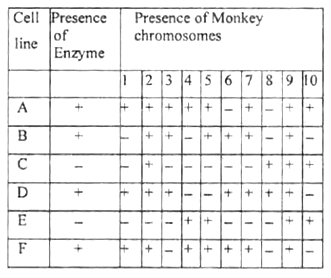 Multiple Choice Questions
Multiple Choice QuestionsWhich one of the following statements regarding 'Endosymbiotic hypothesis of origin of eukaryotes' is INCORRECT?
Mitochondria arose from an α- proteobacterium and plastids arose from cyanobacteria.
The event of engulfment of a photosynthetic cyanobacterium by a host cell was primitive to engulfment of an α-proteobacterium during the eukaryotic origin.
Protists chlorarachniophytes, likely evolved when a heterotrophic eukaryote engulfed a green alga, exemplifying secondary endosymbiosis.
One of the membranes of the engulfed double-membraned cyanobacteria was lost in some of the hosts that eventually led to red and green algae descendants.
The lambda (λ) and P22 phages are two related lamboid bacteriophages. A recombinant lambda phage (λMut) was derived from the wild type lambda phage (λWT) by replacing its CI repressor gene and the CI binding sites with those from the P22 phage. Both the λWT and the λMut were used independently to infect Escherichia coli strain over-producing λWT CI repressor. Following outcomes were surmised
(i) Infection with λWT will lyse the E.coli used.
(ii) Infection with λWT will invariably establish lysogen in the E. coli used.
(iii) Infection with λMut will lyse the E. coli used.
(iv) Infection with λMut will invariably establish lysogeny in the E. coli used.
Which combination of the above statements is correct?
(i) and (ii)
(ii) and (iii)
(iii) and (iv)
(iv) and (i)
Somatic cell hybridization is used to assign a gene to a particular chromosome. When two cell lines from two different species are fused, they form a heterokaryon which tends to lose chromosomes as they divide, preferentially from one species. A panel of cell lines was created from mouse-monkey somatic cell fusions. Each lime was examined for the presence of monkey chromosomes and for the production of a given enzyme. The following results were obtained:

On the basis of these results, which chromosome has the gene that codes for the given enzyme?
Chromosome 10
Chromosome 7
Chromosome 1
CHromosome 5
Given below are a list of some extracellular matrix (ECM) proteins in column A and their characteristics in column B, but not in correct order.
| A | B |
| A. Fibronectin | i. Trimeric protein made from three polypeptides which can twist together into a special triple helix. |
| B. Laminin | ii. Heterotrimeric protein comprising α, β, and γ chains and many of them are large, cross-shaped proteins. |
| C. Nidogen | iii. Dimers of two similar polypeptides linked at their C-termini by two disulfide bonds and contain RGD sequence for binding to certain integrins. |
| D. Collagen | iv. A rod-like molecule also called enactin that cross-links with many ECM proteins and also stabilizes basal laminae. |
Which one of the following is the most appropriate match?
A - i; B - ii; C - iii; D - iv
A - ii; B - iii; C - iv; D - i
A - iii; B - ii; C - iv; D - i
A - iv; B - i; C - ii; D - iii
Select a cellular body which is NOT a part of the nuclear bodies:
P bodies
Nucleolus
Cajal bodies
Interchromatin granule clusters
Which one of the following statements about chromatin is NOT true?
DNA winds approximately 1.65 times around the nucleosomes.
H2A-H2B binds to both the entry and exit ends of DNA in nucleosomes.
Covalent modification of histones influence chromatin compaction.
Non-histone proteins are part of mitotic chromosomes.
During eukaryotic cell division, metaphase to anaphase transition is regulated by degradation of
Cyclin B1
CDK1
Aurora A kinase
Polo-like kinase
A.
Cyclin B1
During eukaryotic cell division, metaphase to anaphase transition is regulated by degradation of cyclin B1.
One of the mechanisms used by bacteria for adaptation to changed environment is altering the transcription of their genes. In this regard, which one of the following responses is NOT found in bacteria?
A gene with two different promoters for expression in different conditions.
use of different sigma factors for transcription of genes.
Expression of alternate α, β and β' subunits.
Expression of anti-sigma factors.
Given below are growth equations where dN/dt is defined as
A. rN/K
B. rN
C. rN[(K-N)/ N]
D. rN[(K - N)/ K]
With reference to the above equations, which one of the following statements is correct?
B represents exponential growth and A represents logistic growth.
B represents exponential growth and D represents logistic growth.
B represents zero growth and C represents logistic growth.
A represents exponential growth and D represents logistic growth.
A species whose life history strategies allow for high intrinsic rates of increase (r-strategist) will also exhibit the following EXCEPT
high tolerance for both environmental instability and low quality resources.
short period of exponential population growth (r).
reproductive strategy that involves random mating, semelparity and little or no parental investment.
survivorship that shows density-dependent mortality, typically exhibiting Type 1 or 2 survivorship curves.
